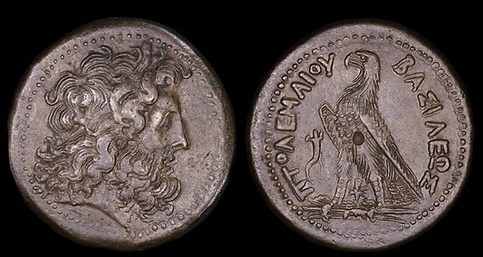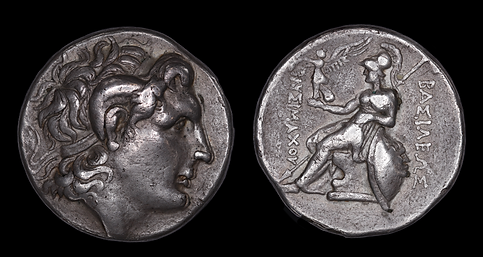
Diomedes Ancient Coins
Coins of Alexander III and the Diadochi

Egypt, Ptolemy III Euergetes, 246-222 BC. Triobol (Bronze, 35 mm, 30.97 g, 12 h), Alexandria. Obv: Diademed head of Zeus Ammon to right, with ram's horn in his hair and over the diadem. Rev. BAΣIΛEΩΣ ΠTOΛEMAIOY Eagle with closed wings standing left on thunderbolt; to left, filleted cornucopia; between eagle's legs, monogram of XP.

Macedonia. Kassander. As regent, 317-305 BC, or King, 305-298 BC. AR Tetradrachm. In the name and types of Alexander III. Amphipolis mint. Struck circa 307-297 BC. Obv: Head of Herakles right, wearing lion skin. Rev: Zeus Aëtophoros seated left; in left field, Λ above torch; kerykeion below throne.

Egypt, Ptolemy I Soter, 305-282 BC. Tetradrachm (Silver, 27 mm, 13.69 g, 1 h), uncertain mint on Cyprus (Salamis or Kition), circa 294-282. Obv: Diademed head of Ptolemy I to right, wearing aegis around neck; small Δ behind ear. Rev: ΒΑΣΙΛΕΩΣ ΠΤΟΛΕΜΑΙΟΥ Eagle with closed wings standing left on thunderbolt; to left, ΣΤ above monogram of Π and A.

Alexander III. Amphipolis mint. Obv: Head of Herakles right, wearing lion skin. Rev: AΛEΞANΔPOY, Zeus Aëtophoros seated left; to left, rooster standing left. 16.95 g 26.0mm

Macedonia. Antigonos II Gonatas, 277/6-239 BC. Tetradrachm (Silver, 30 mm, 17.08 g, 10 h), Amphipolis, circa 274/1-260/55 BC. Horned head of Pan to left, within the centre of a Macedonian shield. Rev. BAΣIΛEΩΣ ANTIΓONOΥ Athena Alkidemos striding left; to left, Macedonian helmet with transverse crest; to right, monogram of EYPM.

Seleucus I Nicator. AR tetradrachm (28mm, 16.97 gm, 8h), Susa, ca. 305/4-295 BC. Obv: Head of Seleucus I right, wearing Attic helmet covered with panther skin and decorated with bull horns and ear, panther skin tied around neck; dotted border. Rev: ΒΑΣΙΛΕΩΣ / ΣΕΛΕΥΚΟΥ, Nike standing right, crowning trophy of arms built on tree, branch at base to right; M below right wing, AX between Nike and trophy below left wing.

Seleukid Kingdom, Seleukos I Nikator. 312-281 BC. AR Tetradrachm (17,09 gm, 5h 26,8mm ). Babylon I mint. Struck in the name of Alexander III of Macedon, circa 311-300 BC. Obv: Head of Herakles right, wearing lion's skin. Rev: Zeus Aëtophoros seated left; monogram in wreath in left field, HP monogram below throne.

Lysimachos AR Tetradrachm. ca 297-281 BC. Obv: Head of deified Alexander right, with horn of Ammon. Rev: BAΣIΛEΩΣ ΛYΣIMAXOY, Athena seated left, holding spear and Nike.

Philip III Arrhidaeus. Obv: Head of Herakles on the right, wearing lion skin. Rev: Zeus Aëtophoros seated on the left, cross-legged, naked to the waist, holding an eagle on his right hand and a long sceptre balled on the left; in the field on the left, a bee; in the field on the right, a spearhead, ALEXANDROU. Drachma c. 323-317 BC. Diameter : 17 mm Die: 12 h. Weight : 4.24 g

Seleucid Kingdom. Antiochos III 'the Great' (222-187 BC). AR Drachm. Uncertain mint, possibly Apameia on the Orontes. Obv: Diademed head right. Rev: ΒΑΣΙΛΕΩΣ / ΑΝΤΙΟΧΟΥ. Elephant standing right. Control: Monogram to right. Weight: 4.07 g. Diameter: 17.75 mm